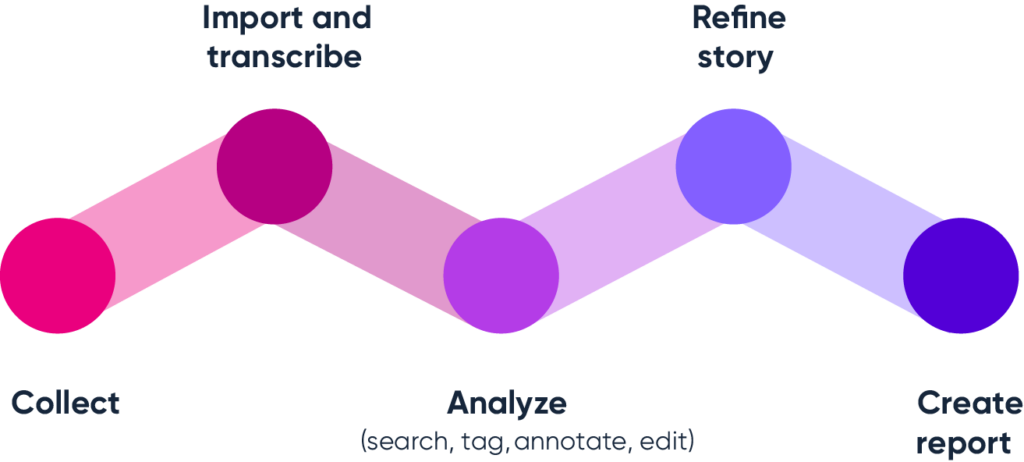Make it stick: 5 tips for video storytelling


Capture imagination

Engage emotions

Break through
In recent years, there’s been a notable push to incorporate storytelling into insights reports, and indeed in all aspects of business today. Storytelling is an important mechanism to help deliver information that stands out from the clutter and resonates with the recipient.
But while there’s been a lot of buzz around this term, it is unclear what storytelling really means in the context of insights reports. Is it the ability to condense key findings into a cohesive narrative? The structure of the report? The visual representation of the data? Or maybe it’s all about the presenter’s delivery of the results? In truth, all of these elements are important. However, there is an additional crucial requirement – connecting the audience to the data.
Stories, according to a Harvard Business Review article (O’Hara, 2014), “create ‘sticky’ memories by attaching emotions to things that happen”. Relating this to insights, even though we are reporting data we still need to engage the emotions of our audience. We can do this by humanizing the numbers or the themes to enable the findings to connect, resonate, and in turn, become memorable. In her 2010 TedTalk Dr. Brené Brown said, “maybe stories are just data with a soul”.
Video open ends in surveys
In person focus groups
Online communities and mobile ethnographies
Online focus groups and interviews
How do we do this? Through small data. While big data can feel unapproachable and abstract, small data tells the human story about how people live, the products they use, the way they use them and so on. Small data helps convey the point and create a sticky memory.
Quotes are good. Images are better. But video is perhaps the most powerful way to create those sticky memories. Cognitively, it is easy to digest. A MIT study (Trafton, 2014) found that the human brain can process a single visual within 13 milliseconds, so imagine how much we absorb watching a short video. It is also undeniably authentic. Seeing faces, hearing voices and understanding emotions creates a different level of connection and empathy.
Within research today, there are multiple sources of video data available, from webcam interviews and focus group recordings to online communities and mobile ethnographies as well as video open ends within surveys.
But simply adding video to your presentation isn’t enough. To really make an impact, it needs thoughtful consideration.
Immerse yourself
in the data but
use video analysis
and management
tools to avoid
drowning in it
Historically, video has been extremely cumbersome to manage. The need for secure storage, hours of plowing through footage and using video editing tools to create clips was burdensome beyond the means of most researchers. Fortunately, research technology makes it easier to harness, with enhanced analytical capabilities, easy clipping and sharing.

Think about your overarching story structure. Is it a traditional three act, a more complex hero’s journey, or something else?
Determining your overall story structure is the essential first step.
What is your narrative, what shape are you going to put around it? It can be a simple three-act structure (beginning, middle and end) or a less linear path, such as the Hero’s Journey or Nancy Duarte’s ‘what is, what could be’ (see Duarte’s TedTalk ‘The secret structure of great talks’ for a good overview of story structure). Here you’ll also want to think about how you’ll humanize the data to connect the audience with it. You may open with a nugget that sets the scene and then broaden out to the trends and themes found in the data. Another approach is to start with a summary of the findings before diving into the details, layering the small data in at various points. Mapping the story on paper (or computer!) is helpful in organizing your thoughts and putting the structure in place.
At a minimum, you need a…

Next think about where video fits within the overarching story
Closely tied to your overall story structure, you next need to consider at what point(s) your video will appear. Is it part of the opening act, a mid proof-point or an end summary? How does the placement tie with the purpose of the video – does it frame the problem, deliver a proof point or summarize the findings? How will this positioning create maximum emotional engagement and impact?
Where will it be played…
As part of the opening act?
A mid proof-point?
The end summary?
Transition points?

Or perhaps you only have video?
You’ll need to balance video length vs viewer engagement vs video purpose
Will you use multiple short clips or one long one? This will of course depend on your overall structure and use of video within that. Beyond this, you need to balance length and attention. Too fleeting a glimpse can be irritatingly short. Too much can become a blur. According to Wistia (2016) viewer engagement drops off after 2 minutes so as a rule of thumb aim to stay below that mark. Just like each slide in your report, slim down your video so that only material essential to the narrative is included.

Whether to have one longer video or a number of shorter ones to determine the best approach.
Is the video (intended to be) shareable?
Is the video only being used as part of the presentation or will it be shared afterwards? Either way, it is essential to have the relevant consent from participants on its use. Permissions are fundamental. It is a foundation of research ethics, as set out in the 1947 Nuremberg Code and expanded upon within the 1964 Helsinki Declaration. Today, legislations such as the General Data Protection Regulation
(GDPR) and the California Consumer Privacy Act (CCPA), add legal obligations to the ethical ones.
Under GDPR, individuals can withdraw their consent to appear in a video at any time, even if they gave their initial approval. It’s therefore crucial to review your company’s privacy policies to ensure that you have the ability to take down published videos wherever they may be located when participants no longer want them to be in use. Research technology solutions are an important mechanism to facilitate viewing and sharing of video data while keeping it secure and facilitate legal compliance.
Permissions
Do you have the appropriate consent?
Self-explanatory
Is the material readily understandable as stand-alone content?
Accessible
Where will it be stored? How will it be accessed, and by whom?
Used thoughtfully, video storytelling provides breakthrough moments
In the highly competitive business world, the measure of success for insight reporting is not simply the delivery of findings, but the telling of stories in ways that emotionally connects the findings to the audience. This connection provides urgency in the call to action, facilitates recall beyond the meeting room and empowers faster decision making. Stories and the video journeys that illustrate them become memorable and are filled with emotions and non-verbal information. When connected back to research questions, central themes can emerge through video, becoming tangible, clear and diverse.
Related resources
Emotions: the key to unlocking insights for results
Emotions: the key to unlocking insights for results Emotions: the key to unlocking insights for results Clarity, Connection, Conversion. Seamlessly Achieved. In the world of customer experience (CX), many programs fall short by focusing on outdated score-chasing metrics like NPS without realizing the untapped potential of emotional insights. This eBook is your guide to unlocking […]

Integration: the new frontier of insights
Integration: the new frontier of insights Integration: the new frontier of insights Efficiency, intelligence, insight. All in one. The new frontier of insights is here and it’s swifter, smarter and scalable. Market research professionals know the challenge all too well: endless hours spent preparing data and reports, leaving less time for uncovering the insights that […]

Passion sparks action: F’inn champions mental health
Passion sparks action: F’inn champions mental health Passion sparks action: F’inn champions mental health Using innovative tools and rigorous data, F’inn and Forsta shine a light on mental health challenges in America F’inn, a US based insights consultancy, didn’t just want to study mental health—they felt compelled to act. They knew exactly who to team […]

Learn more about our industry leading platform
FORSTA NEWSLETTER
Get industry insights that matter,
delivered direct to your inbox
We collect this information to send you free content, offers, and product updates. Visit our recently updated privacy policy for details on how we protect and manage your submitted data.